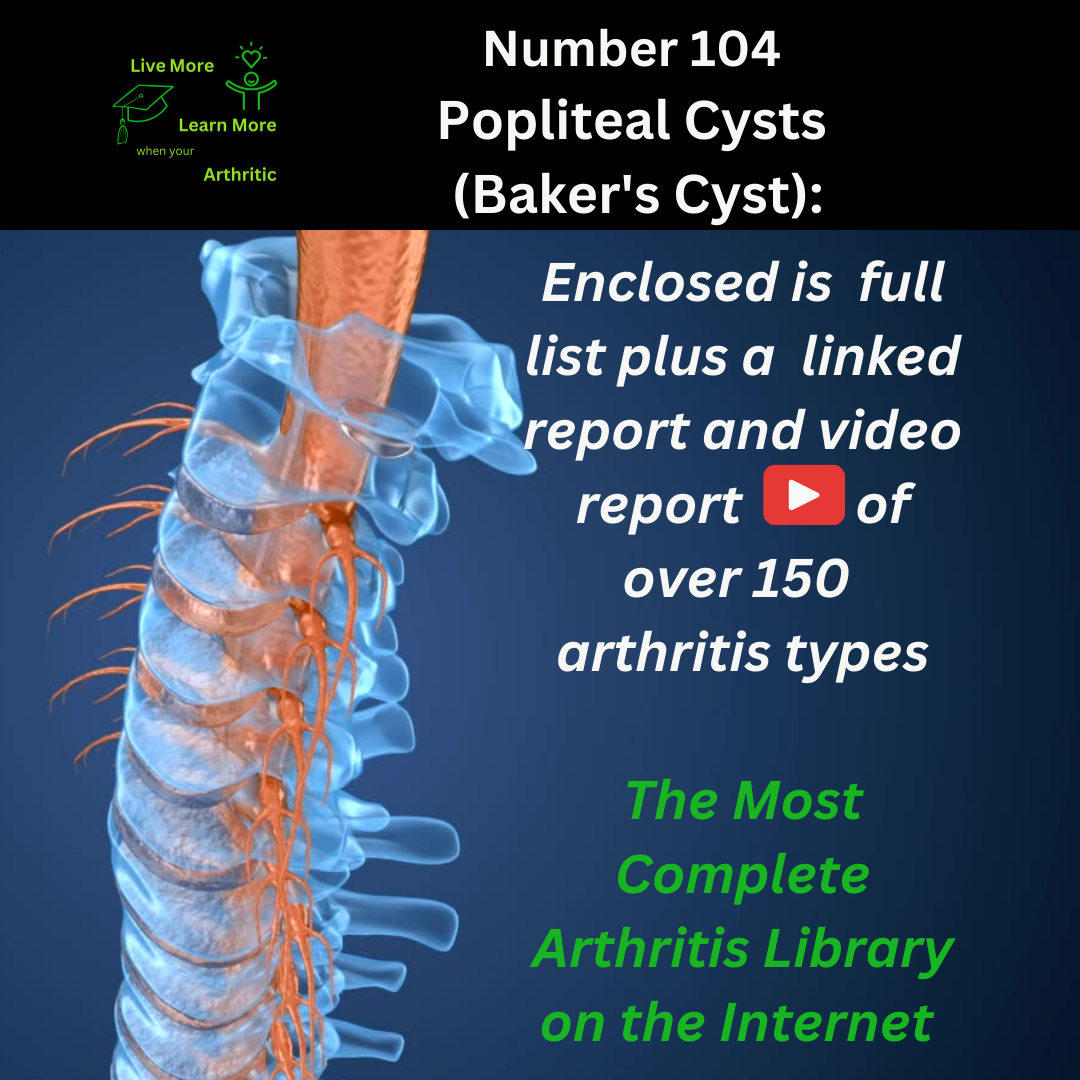
Popliteal Cysts (Baker’s Cyst): Number 104 of around 150 types of Arthritis
Unveiling the Mysteries of Popliteal Cysts (Baker’s Cyst): A Tale of Joints and Resilience
Welcome to the realm of popliteal cysts, also known as Baker’s cysts, where joints harbor secrets and challenges. Join us on a journey to understand this condition, exploring its impact on the body and the potential for proactive management.
 Targeting the Knee’s Backstage: Where Popliteal Cysts Arise
Targeting the Knee’s Backstage: Where Popliteal Cysts Arise
In the intricate orchestra of joint health, popliteal cysts take center stage behind the knee. This fluid-filled sac can emerge as a result of underlying joint conditions, creating a bump that hints at deeper struggles within.
Hope in the Horizon: Exploring Remission and Relief
Can popliteal cysts recede into remission? With appropriate treatment and lifestyle adjustments, periods of remission are possible. However, vigilance is key, as the cyst may reappear if underlying joint issues persist.
The Anatomy of a Cyst: Causes and Triggers Unveiled
What sets this cyst in motion? Popliteal cysts often stem from joint conditions like arthritis or cartilage tears, where excess synovial fluid finds refuge in the popliteal space behind the knee. Injury, inflammation, or wear and tear can trigger this fluid buildup.
Symptoms Unmasked: A Knee’s Silent Protests
How does a popliteal cyst announce its presence? Symptoms include a visible swelling behind the knee, stiffness, discomfort, and occasionally, limited range of motion as the cyst presses on surrounding tissues.
The Age Factor: Onset and Surprises
Who’s most likely to encounter a Baker’s cyst? While it can occur at any age, adults over 40 are more susceptible, often as a result of degenerative joint changes that come with age.
Life’s Ledger: The Long-Term Impact
Does a Baker’s cyst impact life expectancy? Generally, it doesn’t affect lifespan directly, but it can impact quality of life and mobility if left untreated or if underlying joint issues persist.
Autoimmune Anecdotes: Is This Arthritis in Disguise?
Is a Baker’s cyst tied to autoimmune arthritis? Not directly. However, it often coexists with joint conditions like osteoarthritis or rheumatoid arthritis, hinting at interconnected joint health challenges.
Risk Factors Revealed: Understanding Vulnerabilities
Who’s at risk of developing a popliteal cyst? Those with underlying joint issues, such as arthritis or meniscal tears, are more prone. Additionally, athletes or individuals with frequent knee strain may be vulnerable.
Complications Unveiled: Navigating Beyond the Cyst
What perils lie in wait for the unsuspecting knee? Complications can include cyst rupture, leading to swelling and pain, or pressure on surrounding nerves and blood vessels, affecting mobility and comfort.
The Swell and Soreness: Inflammation’s Role
Is swelling a key player in a Baker’s cyst? Absolutely. Inflammation within the joint can trigger synovial fluid accumulation, creating the cystic pouch behind the knee.
Tender Joints: Feeling the Weight of a Cyst
Do tender joints accompany a Baker’s cyst? Yes, surrounding joints may become tender or stiff due to inflammation and fluid accumulation, impacting everyday activities.
Cartilage Concerns: The Ripple Effect
Why does cartilage matter in a Baker’s cyst? Cartilage damage can lead to joint instability and inflammation, contributing to the development of a popliteal cyst as the joint tries to compensate.
Comorbidity Chronicles: Interconnected Health Challenges
Are there related conditions to watch for? Yes, a Baker’s cyst often coexists with joint issues like osteoarthritis or meniscal tears, necessitating comprehensive joint health assessments.
Embracing Proactivity: Elevating Quality of Life
Can proactive measures improve life with a Baker’s cyst? Absolutely. Gentle exercise, physical therapy, and lifestyle modifications can alleviate symptoms, enhance joint health, and promote mobility.
Complications Unveiled: A Pathway to Awareness
What perils await those unprepared? Cyst rupture, chronic pain, joint stiffness, and reduced mobility are among the potential ramifications of untreated or persistent Baker’s cysts.
Demographic Dimensions: Who’s in the Cyst’s Crosshairs?
Who’s more affected by Baker’s cysts? They occur more frequently in women than men, often in middle-aged adults grappling with joint health challenges.
 Connected Conditions: Recognizing Joint Health Alliances
Connected Conditions: Recognizing Joint Health Alliances
Are there intertwined diseases to consider? Baker’s cysts may be associated with conditions like rheumatoid arthritis or meniscal injuries, emphasizing the importance of comprehensive joint care.
In conclusion, while popliteal cysts present unique challenges, proactive management and joint health awareness can pave the way towards improved quality of life. Each step towards understanding and proactive care offers hope and resilience in the face of joint health complexities, illuminating pathways towards joint restoration and renewed mobility.

